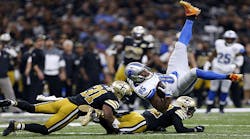'Punch Drunk’: The Brains of 202 Football Players, 177 Cases of Chronic Traumatic Encephalopathy
In a report published in 1928 in the Journal of the American Medical Association (JAMA), Dr. Harrison S. Martland coined the phrase “punch drunk” to describe the neurological symptoms exhibited by boxers who were exposed to repetitive head trauma in the ring. Eventually, the condition described by Martland was named dementia pugilistica, and now is known as chronic traumatic encephalopathy (CTE).
A large team of researchers have evaluated the brains of 202 deceased former football players who played high school, college, semiprofessional and professional football and found that the brains of 177 players (87 percent) showed signs of chronic traumatic encephalopathy (CTE). Of the 14 deceased players who only played in high school, three showed mild cases of CTE. However, the longer the players were involved in the game and higher the level of performance, the more likely they were to have developed more severe cases of CTE.
“Clinicopathological Evaluation of Chronic Traumatic Encephalopathy in Players of American Football,” published in the July 25 issue of JAMA, found that of the 111 deceased NFL players examined, 110 had brains that exhibited signs of CTE (99 percent), a progressive neurological condition that results from repeated head trauma. The condition can result in mood swings, depression, anxiety, feelings of hopelessness, violent outbursts, cognitive impairment and dementia and only can be diagnosed by an autopsy after death.
The median age of death for players with mild CTE was 44 years. Researchers noted that the most common cause of death for study participants with mild CTE was suicide (27 percent). The median age of participants with severe CTE pathology was 71 years, and the most common cause of death (47 percent) was neurodegenerative – dementia- and parkinsonian-related.
“Nearly all of the former NFL players in this study had CTE pathology,” wrote the researchers, “and this pathology was frequently severe. These findings suggest that CTE may be related to prior participation in football and that a high level of play may be related to substantial disease burden.”
They went on to say that several other football-related factors – such as age at first exposure to football, duration of play, player position, cumulative hits and linear and rotational acceleration of hits – could influence CTE risk and disease severity.
The NFL, responding to a request for comment from CNN, said the organization will continue to work with “a wide range of experts to improve the health of current and former NFL athletes,” and added that many unanswered questions “relating to the cause, incidence and prevalence of long-term effects of head trauma such as CTE” remain.

